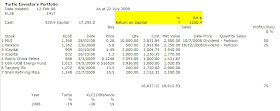
Saw this on the Star written by one of the folks from LEA(www.lea.my). They suggested based on their research, you need to master four areas that you can see in the chart. Since have good intentions to train potential entrepreneurs, I would be less cynical with my views on what they wrote on
http://biz.thestar.com.my/news/story.asp?file=/2009/7/18/business/4342223&sec=business. Looking at their website, the reason of their existence is this:
Leaderonomics Entrepreneur Academy (LEA) is an organization dedicated to the pursuit of leadership, talent and entrepreneurial development and understanding at strategic to operational levels, and through a range of learning, consulting and partnering services. We work with all ages and leadership levels based on leading practices, insights and trends from global MNCs and leadership academia.
LEA is established with the purpose to develop and grow entrepreneurs in the country whilst building the entrepreneurial community locally and globally.
LEA's objective is to elevate the entrepreneur eco-system by synergizing new and established entrepreneurs along with investors to create a healthy sustainable economy.
They are charging you a few hundreds Ringgit to attend their workshop(btw, it's very reasonable).

I have no problems with their mission but I am concern with them teaching "research" models that is perfect in theoretical world but lack of relevance in the real world. I'm also afraid that it will turn out to be some kind of motivational or pep talk sessions that keep you fire up for a while, fizzle out when you wake up the next day.
The four areas of mastery is like nothing more than stating the obvious just like this scene.

I'm not trying to thrash folks in LEA but they got to do a better job.
If anyone of you decided to be an entrepreneur, lesson # 1 is this : be dead sure you have enough cash. Most entrepreneur fails within six months because they are running out of cash. Cash flow is number one problem when you start a new business.
Mistake # 2, jumping around business ideas thinking that they can build a conglomerate like Robert Kuok, trading sugar, to owning ships, cinemas, plantations, hotel, etc.
Mistake # 3, bringing in a wrong partner. When your business begins to overcome the inertia, achieving critical mass, bringing you consistent cash flow and thinking of scaling up. Be careful of bringing in a wrong new partner to fund your expansion. Be sure your partner remains sleeping partner or be a complementary partner. Be sure their wife don't get involve too. This is often a source of tension leading to business break up.
Mistake #4, not bringing in professional management to free you up to focus on business expansion. Entrepreneurs have very strong technical or hands on skills, they are so good that they look other people no UP. That's why you will see some one man show will remain one man show. But smart entrepreneur will quickly hire a branch manager so that he can open his second branch.
Mistake #5, no succession planning. Some entrepreneurs manage to bring in professional management but did not pay attention to succession planning. As a result, they are falling into the curse of wealth cannot last more than 3 generations. A smart entrepreneur will want to let go and share their wealth with the public and if they lack of qualified family members to run the business, let the pro do the job and manage the wealth through a foundation. This is an area the westerner done a much better job than Asian.
Guys, I am getting more and more abstract but hope you will find it useful.




























